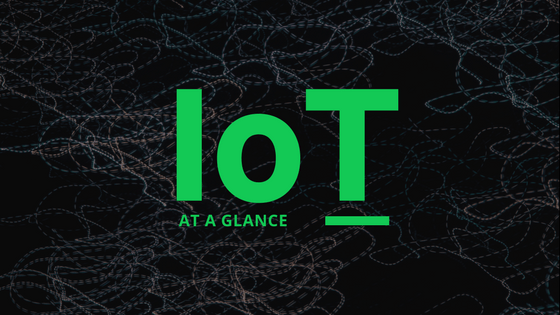Virtual Reality, Robotics, or in-car entertainment are the Consumer Electronics Trends that will push the industry forward in 2018.
The Consumer Electronics industry is continually growing and evolving. This industry has seen exciting new developments in recent years and at a rapid pace. But the competition in the field has exponentially increased, leading to aggressive investment and innovation.
Here we outline the top 5 Consumer Electronics trends that will shape the industry innovations for 2018 and the years to come.

1.1. Consumer Electronics Trends for Virtual Reality
Virtual Reality market is expected to reach $40B by 2020. And apart from its potential in fields such as Healthcare and Education, its most common application so far is in Gaming and Entertainment.
The International Data Corporation forecast that enormous growth is expected in the next few years for VR. It states that the headset market will grow to a staggering 81.2 million units by 2021. Taking into account that prices for high-end headset range from $400 to $800, there is a vast potential for Consumer Electronics and VR manufacturers.
Therefore, the Virtual Reality trends for Consumer Electronics that are growing at a higher pace are Virtual Reality Computer Hardware and Personal Communication Services. We can surely expect future announcements to be made in the following months.

Source: Linknovate.com
1.2. Key Organizations in Consumer Electronics for the Automotive Industry
Although the industry has the headset and controllers aspects covered, the most significant challenge is to provide content that appeals to a mass audience, combined with the confusion associated with a lack of cross-platform support.
On that subject, Samsung has teamed up with different organizations to entertain Virtual Reality. On the one hand, they have started to stream live music concerts through Live Nation. And on the other hand, they have partnered with the Major League of Baseball (MLB) to offer immersive access to players, ballparks and critical baseball moments.
As for HTC, they have recently launched Vive Studios to expand VR content. They plan to launch titles in categories ranging from education to design, sports, and things cinematic.
| Name | Score | Pubs | Confs | Grants | Patents | TMs | News | Web |
| 1227.2 | – | – | – | – | – | 56 | – | |
| 1003.8 | – | 4 | – | – | – | 126 | – | |
| 818.3 | – | – | – | – | 1 | 42 | – | |
| 428.4 | – | – | – | – | – | 45 | 4 | |
| 339.1 | – | – | – | – | – | 38 | – | |
| 289.3 | – | 2 | – | – | – | 51 | – | |
| 222.0 | – | – | – | – | – | 21 | – | |
| 165.1 | – | – | – | – | 1 | 30 | – | |
| 134.1 | – | – | – | – | – | 20 | – | |
| 96.9 | – | – | – | – | – | 12 | – |
Top 10 Organizations Worldwide in Virtual Reality Consumer Electronics. Source: Linknovate.com
NOTE: Since we are constantly updating our data, results may vary. Click on the link for more updated results
1.3. Leader Countries in Consumer Electronics for Virtual Reality
As expected, the United States is the country with a higher number of organizations innovating on the matter. However, we can see a strong East-Asian presence, with countries such as Japan, China, and South Korea occupying high positions in the ranking.

Source: Linknovate.com
2.1. Consumer Electronics for Cars over Time
Today, many of us connect our phones to the car to enable ubiquitous connectivity. From navigation and transit maps or listening to our favorite music, to smartphone projection systems such as Apple‘s Carplay or Google‘s Android Auto that are optimized for use while driving.
But a large number of cars already have their own dedicated data connections. These built-in connections will increasingly become standard on most vehicles in the coming years to support technologies such as autonomous driving and over-the-air updates.
In the future people expect a seamlessly integrated in-car infotainment when they enter a car.
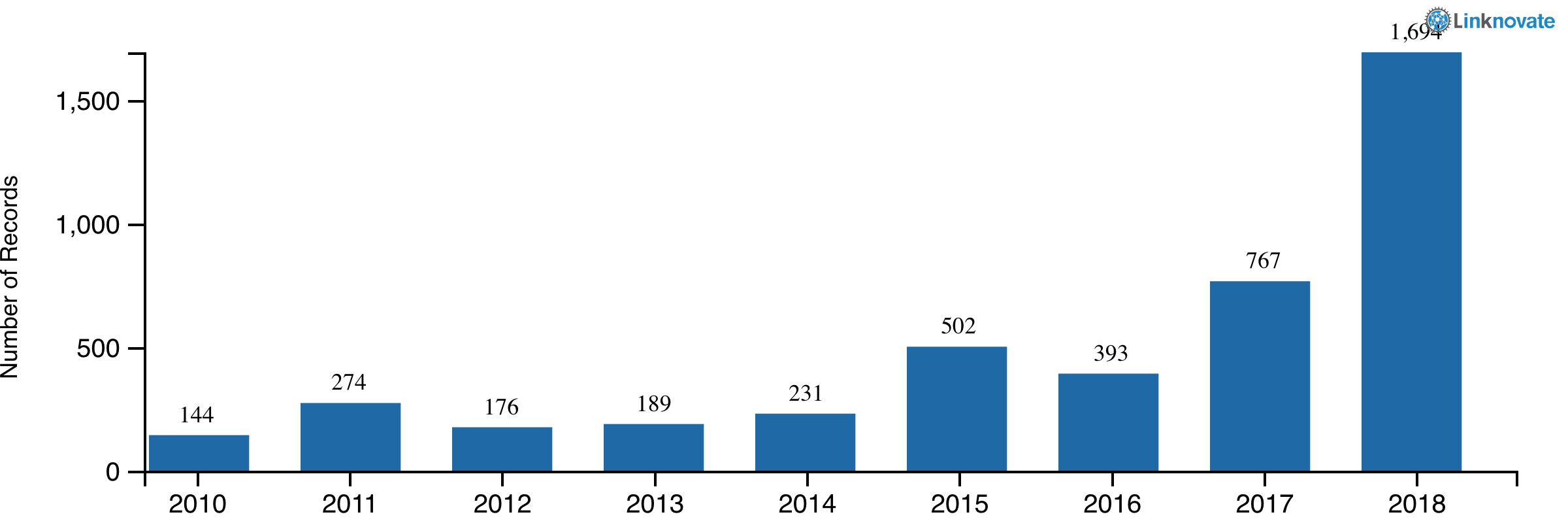
Source: Linknovate.com
2.2. Key Organizations in Consumer Electronics for the Automotive Industry
Out of the top 10 organizations, five are consumer electronics manufacturers (Microsoft, Google, Samsung, Panasonic, and HTC). And four are major carmakers (GM, BMW, Toyota, and Volkswagen). They are collaborating together to bring new, customized products to the market.
Volkswagen and Ford have both made announcements that their cars will soon expose an interface for Amazon’s Alexa (for the weather, navigation, and additional features). Drivers will be able to ask Alexa about the status of the car (level of fuel or tire pressure, for example) or the traffic before leaving home. And also, the data will sync with home intelligent assistants. A step forward for highly-autonomous cars.
Continental had also made a grand announcement last year. They are developing Ac2ated Sound, a new cutting-edge sound system that reduces car weight and saves space by eliminating the bulk of conventional speakers. These new systems use small actuators that ‘excite’ various interior components to create sounds, such as the dashboard, ceiling, or doors.
| Name | Score | Pubs | Confs | Grants | Patents | TMs | News | Web |
| 704.8 | – | – | – | – | – | 69 | – | |
| 493.2 | – | – | – | – | – | 48 | – | |
| 248.7 | 2 | – | – | – | – | 66 | – | |
| 230.5 | – | – | – | – | – | 84 | – | |
| 184.0 | – | 1 | – | – | 11 | 64 | – | |
| 157.9 | – | – | – | – | – | 46 | – | |
| 141.5 | – | 1 | – | – | – | 18 | – | |
| 126.2 | – | 1 | – | – | 1 | 39 | – | |
| 119.6 | – | – | – | – | – | 22 | – | |
| 118.2 | – | – | – | – | – | 19 | – |
Top 10 Organizations Worldwide in Consumer Electronics for the Automotive Industry. Source: Linknovate.com
NOTE: Since we are constantly updating our data, results may vary. Click on the link for more updated results.
2.3. Top Entities’ Comparison
Microsoft, Samsung, and Google are the leading corporations worldwide developing Consumer Electronics for the Automotive Industry. In particular, Google’s spinoff, Waymo, improves transportation by building on software and sensor technology developed in Google’s labs.
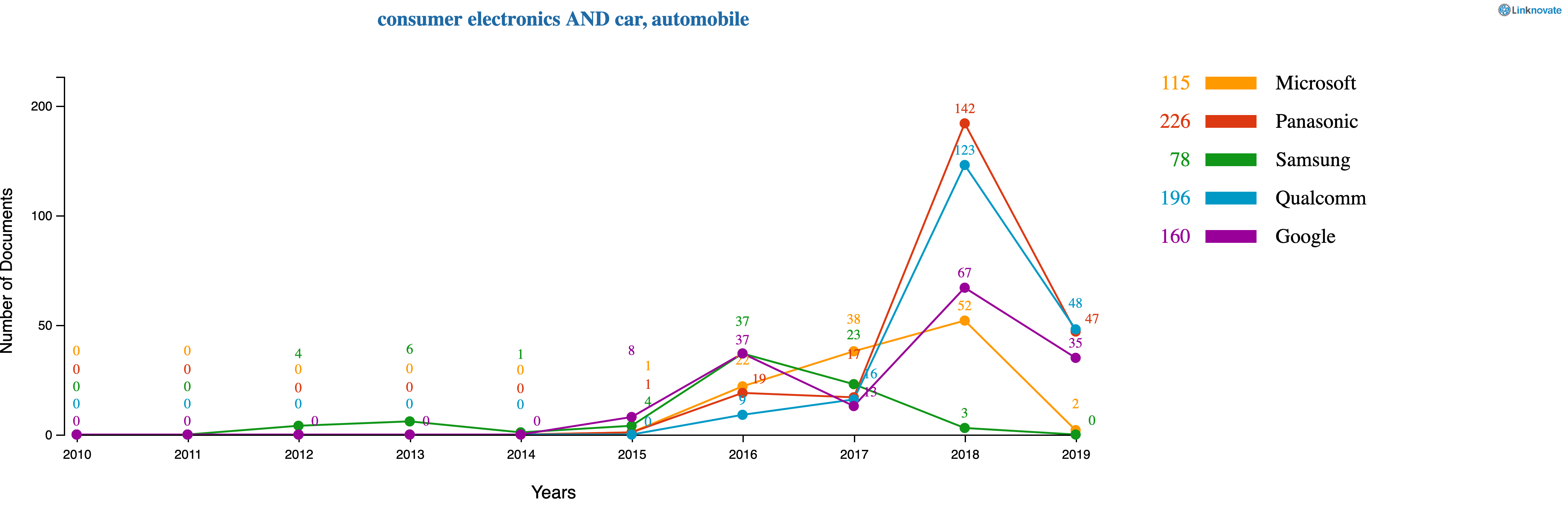
Source: Linknovate.com
3.1. Smart Homes’ Trends
We can see that the growing trends for Smart Homes are related to Computer Network Management Softwares and Computer Storage Devices so we can expect related future announcements.
It catches our attention that one of the trends that grew the most since 2014 was the Internet of Things. Household appliance manufacturers are integrating their products with IoT technology to make customers lives more comfortable and convenient.
Smart TVs are currently present in most homes, and Voice Assistants such as Amazon Echo or Google Home were one of the most popular presents last Christmas. But Smart Homes’ possibilities go further.
For instance, LG has created Homechat, an app that enables users to monitor their appliances (refrigerators, cookers, washing machines…) from anywhere through their smartphones. This technology was initially introduced in South Korea but is gradually moving to other markets.

Source: Linknovate.com
3.2. Key Organizations in Consumer Electronics for Smart Homes
All the top 10 organizations worldwide working on the topic are private companies. And when looking at the aggregated set of data, we see that Corporations and Small Companies make up for almost 89% of all the organizations working on the topic.
Samsung is one of the companies betting the most on this type of technology. They have launched SmartThings, a ‘brain’ that wirelessly connects a wide range of smart devices and makes them work together.
Another interesting player is Control4. They provide consumers with the ability to integrate music, video, lighting, temperature, security, communications, and other functionalities into a unified home automation solution.
| Name | Score | Pubs | Confs | Grants | Patents | TMs | News | Web |
| 968.9 | – | – | – | – | – | 53 | – | |
| 444.2 | 1 | – | – | – | 2 | 85 | – | |
| 386.3 | 3 | 4 | – | – | 8 | 62 | – | |
| 264.3 | – | – | – | – | – | 14 | – | |
| 228.6 | – | – | – | – | – | 49 | – | |
| 137.5 | – | – | – | – | – | 22 | – | |
| 135.6 | – | – | – | – | 1 | 10 | – | |
| 114.4 | – | 2 | – | – | – | 19 | – | |
| 111.7 | – | 1 | – | – | – | 25 | – | |
| 110.0 | – | – | – | – | 4 | 27 | 5 |
Top 10 Organizations Worldwide in Consumer Electronics for Smart Homes. Source: Linknovate.com
NOTE: Since we are constantly updating our data, results may vary. Click on the link for more updated results.
3.3. Organization Prevalence per Year
We can see that SMEs and Corporations’ prevalence was virtually the same during the first years of the decade. However, SMEs and startups prevalence has been growing since 2014 as we have been witnessing different newcomers and interesting solutions.
EyeSight transforms any wi-fi connected home security camera into a Smart AI Guard with intelligent-sensing capabilities that sends homeowners notifications when a person that is not recognized within the system enters the home.
Sengled integrates consumer electronics with energy-saving LED bulbs to enhance the connected home with technology.
And there’s also HiMirror, a smart mirror that scans the face and tracks skin beauty products’ effects, so the user knows which products are working and which are not. It also is a streaming device that syncs with Spotify or Youtube.
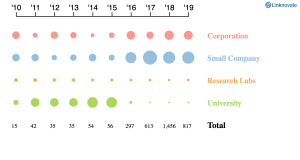
Source: Linknovate.com
4.1. Leading countries in Consumer Electronics for Healthcare
On the one hand, Consumer Electronics are becoming smarter as a result of product innovations and increased interconnectivity between products.
On the other hand, the aging population in Europe demands efficient health management in all areas of life, at the hospital, the private clinic, and at home. The aim is to detect diseases earlier and to treat them more individually. This helps patients remain independent longer and to prevent emergencies.
So there is market potential for applications that offer solutions for these trends, also known as ‘e-health’ and ‘telemedicine.’ This is what makes it one of the most attractive Consumer Electronics trends for both the customers and the industry.
As a result, European organizations are leading the market, followed by the Americans and China and Japan in the Asian continent.

Source: Linknovate.com
4.2. Key Organizations in Consumer Electronics for Healthcare
Out of the top 10 organizations, 5 belong to the Academia (Universities and Research Labs), and 5 are companies (Corporations, SMEs, and Startups). However, when looking at the aggregated set of records Linknovate has collected for the topic, we can see that enterprises make up 65% of the total organizations.
Mitsubishi‘s first position may seem odd at first, but they have different patents in the field for a power control system that measures health data. Same with LG. They have researched a new method for recognizing muscular activities based on air-pressure sensors and air-bladders.
As for Canary Medical, they too have several patents in the field. They are developing different devices, systems, and methods for using and monitoring various kinds of implants in the human body.
| Name | Score | Pubs | Confs | Grants | Patents | TMs | News | Web |
| 32.9 | – | – | – | 3 | – | – | – | |
| 27.5 | – | 7 | – | 1 | – | – | – | |
| 27.5 | 1 | – | – | 1 | – | – | – | |
| 27.0 | 1 | – | – | – | 50 | – | – | |
| 25.9 | – | – | 4 | – | – | – | – | |
| 22.3 | 2 | – | 3 | – | – | – | – | |
| 21.0 | 2 | 2 | 3 | – | – | – | – | |
| 19.8 | – | – | – | 2 | – | – | – | |
| 19.7 | – | 1 | 1 | 1 | 6 | – | – | |
| 19.1 | – | – | – | 8 | – | – | – |
Top 10 Organizations Worldwide in Consumer Electronics for Healthcare. Source: Linknovate.com
NOTE: Since we are constantly updating our data, results may vary. Click on the link for more updated results.
4.3. Phillips Collaborations in Consumer Electronics for Healthcare
Phillips bet on Healthcare is ever growing, and they are collaborating with a wide range of European organizations. For example, they have launched the Phillips eCareCompanion suite which allows chronic-disease patients to monitor their illness constants at home, see data analytics on their smartphones, and share the data in the cloud with their practitioner.
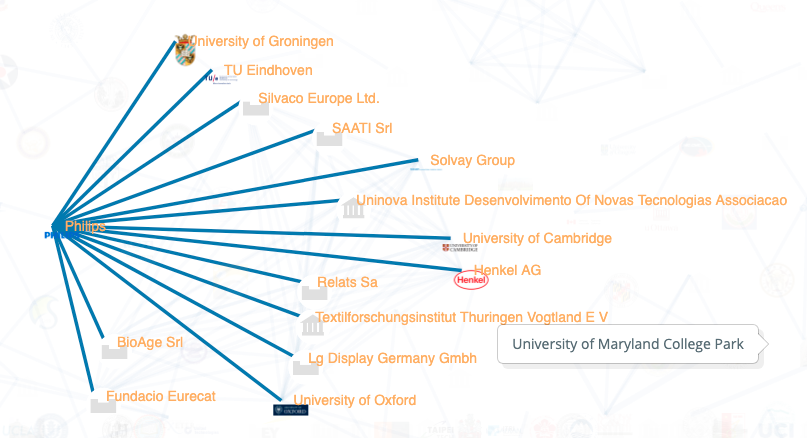
Source: Linknovate.com
5.1. Robotics for the Consumer Electronics Industry Evolution
During 2018, robotics will continue to play a big part in the Consumer Electronics Industry. The rise in automation and robotics technology adoption will improve productivity and reduce production costs.
When looking at the aggregated set of records Linknovate has collected for Robotics and Automation in the Consumer Electronics industry, the general trend looks like the sector is growing by the year. There have been two remarkable leaps in 2015 and 2017, which indicates that the industry is growing in maturity, and we can expect new products and services to hit the market in the following months.
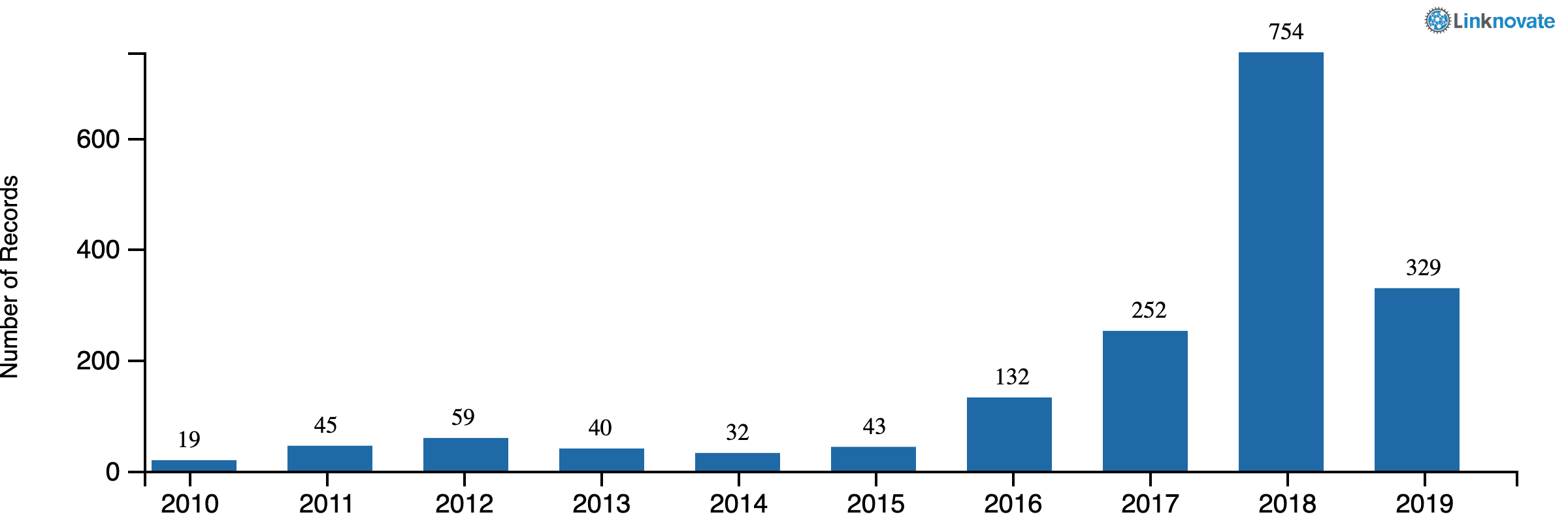
Source: Linknovate.com
5.2. Key Organizations using Robotics for Consumer Electronics
Academia (Research Labs and Universities) only represent 16% of all the organizations working in the field. However, one Research Institute sneaks in the top 10 ranking. The Israeli Russell Berrie Nanotechnology Institute has been researching the use of nanoparticles in flexible sensors for the Consumer Electronics industry.
Samsung is well-known for its robotic vacuum cleaners, but they plan on extending their offer. They have recently invested $ 6M in Intuition Robotics, an Israeli startup that has created ElliQ, a robotic companion for the elderly.
As for robotics corporation ABB, they are focusing on improving robotic cell design and optimization.
| Name | Score | Pubs | Confs | Grants | Patents | TMs | News | Web |
| 565.8 | – | – | – | – | – | 39 | – | |
| 129.3 | 1 | – | – | – | – | 36 | – | |
| 119.0 | – | 7 | – | – | 4 | 28 | – | |
| 107.6 | – | – | – | – | – | 10 | – | |
| 96.2 | – | – | – | – | – | 10 | – | |
| 76.6 | – | – | 1 | – | – | 7 | – | |
| 53.8 | – | 1 | – | – | – | 12 | – | |
| 49.8 | – | – | – | – | – | 12 | – | |
| 44.7 | 2 | 5 | – | – | – | 6 | – | |
| 42.3 | 1 | – | – | – | – | – | – |
Top 10 Organizations Worldwide in Robotics for Consumer Electronics. Source: Linknovate.com
NOTE: Since we are constantly updating our data, results may vary. Click on the link for more updated results.
5.3. Grants to Robots for the Consumer Electronics Industry
Since 2010, there’s been a total of $23.9 M of public funding granted to 30 projects for robots in the Consumer Electronics industry.
The University of Cambridge, leading the 1D-Neon project, was the organization that received the most substantial amount of money. Almost $ 10M to develop fiber-based smart materials along with an integrated technology platform.

Source: Linknovate.com









